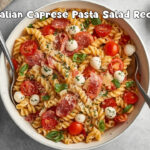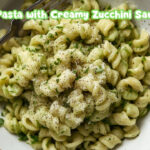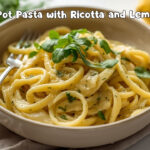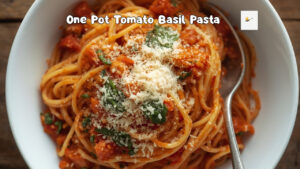Table of Contents
TogglePenne vs Rigatoni was one of the first questions I asked when I started exploring pasta dishes at Pastasphere. I constantly faced the question of which is better?” Both penne and rigatoni have unique strengths, and the best choice depends on the sauce and recipe you’re using. Penne is best for light sauces like pesto, while rigatoni is ideal for thick, meaty sauces due to its ridges and larger shape.
In this guide, you’ll find a complete answer. We’ll explore every detail from shape, texture, sauces, recipes, and history, so that you won’t need to look anywhere else.
What’s the Difference Between Penne vs Rigatoni?
In this section, I’ll break down the foundational contrasts. Both are extruded type pastas, which means dough is forced through a mold to create their signature tubular pieces.
The Tale of Penne
Penne are shorter tubes with ends cut at an angle, making them resemble little quills. Originally made from wheat flour, penne’s name comes from Italian penna, deriving from Latin “penna,” meaning feather or quill.
Penne was created in 1865 by Giovanni Battista Capurro, a renowned pasta maker from San Martino d’Albaro (Genoa). His patent for a diagonal cutting machine was a groundbreaking invention, intended to imitate the tip of a writing instrument. Today, chefs can choose between fresh pasta and dried penne. After the initial crushing of grains, dough is formed, dried, and shaped.
Penne come in sizes that are varying depending on preference. You’ll often see 3 cm (1 in) mezze penne (lit. ‘half pens’) and 5 cm (2 in) penne. There are two main variants: penne rigate (with ridges) and penne lisce (with a smooth surface). Some manufacturers have also produced Pennoni, which are even wider for chunkier sauces. The texture of ridged penne rigate helps sauces cling, making every bite rich.
The Tale of Rigatoni
On the other hand, rigatoni are larger than penne and ziti. They are slightly curved, but not as curved as elbow macaroni. Their long length and pronounced spiraling make them stand out. Rigatoni form a big tube with ends of rigatoni cut perpendicular to the tube walls, unlike penne’s angled ends.
The word rigato means striped in Italian, hence the name rigatone, a ruled, augmentative form indicating a larger size. Rigatoni are associated with the cuisine of southern and central Italy and are particularly favored south of Italy, especially in Sicily.
Chefs often serve a smaller version called Rigatoncini, a smaller version similar in design but close to the size of penne. This shape is a favourite pasta shape for many home cooks. Their eponymous ridges create an adhesive surface that is better for holding chunky ingredients against surfaces, which is critical for capturing every bit of sauce.
Is Ziti similar to Penne & Rigatoni?
Yes, ziti is similar to penne and rigatoni; all three are short, tube-shaped types of pasta that you may see in baked dishes or hearty pasta meals. However, at first glance, they look alike, but each one has its own little personality.
Ziti is usually smooth and has straight-cut ends. It’s more delicate than the other two types and is most commonly used in baked dishes, such as the classic baked ziti. Its smooth surface doesn’t cling to sauce, but when it’s layered perfectly with cheese and baked, it does.
Can You Substitute Penne and Rigatoni?
Absolutel, but consider each shape’s strengths. In my experience:

- Penne works great in light, fresh recipes like pesto-based salads. Their moderate width grips pesto easily.
- Rigatoni shine in baked casseroles and stews with heavy, chunky sauces, as their ridges hold onto every fleck of ingredient.
If a recipe calls for penne and you only have rigatoni, try reducing sauce volume slightly so it’s not overwhelmed by the larger tubes. Conversely, using penne in a hearty rigate dish may leave the sauce slipping off smooth-sided pasta.
Whole Grain Wonders for Rigatoni and Penne

Whole grain pasta options exist for both penne and rigatoni. They add a slightly nuttier flavor and are higher in fiber and nutrients. Whole grain penne is especially good with fresh tomato and basil sauces.
Whole grain rigatoni pairs beautifully with roasted vegetables and heavier tomato-based sauces.
Gluten-Free Options
Today, you can find both rigatoni and penne in gluten-free varieties. These are made from:
- Brown rice flour
- Corn
- Quinoa
- Lentils
These versions still maintain a firm bite and work well with most sauces. If someone in your home has gluten intolerance, there’s no need to skip pasta night.
Healthful Twists with Rigatoni and Penne
While traditional pasta is made from durum wheat semolina, more health-conscious versions have entered the market:
- Penne with Veggies: You can find penne made with spinach, beet, or lentils, adding more fiber and nutrients.
- Rigatoni with Protein: Chickpea or black bean rigatoni brings extra protein and a nutty flavor.
Choosing the healthier versions of penne and rigatoni lets you enjoy your favorite dishes with a more mindful approach.
Pasta shapes Similar to Penne & Rigatoni
While this guide centers on penne and rigatoni, it’s helpful to see how they compare to related varieties:
- Ziti: Similar in length to rigatoni but without ridges. Often cut like penne but larger.
- Elbow Macaroni: Small, curved as elbow macaroni pieces; perfect for soups and mac-and-cheese.
- Pennoni: Large, wider tubes; a heartier cousin of penne.
- Rigatoncini: A smaller version, excellent when you want rigatoni texture in a bite-sized form.
- Fusilli, Farfalle, Shells: Each captures sauce differently—fusilli’s twists, farfalle’s bow ties, and shells’ concave shape.
Cooking Method
Mastering dishes with either penne or rigatoni means understanding how they are traditionally cooked al dente, as I always do in my kitchen.
When thinking about Penne vs Rigatoni, it’s not just about shape—it’s also about cooking time and texture. Cooking pasta right is key to any great dish. Here’s my simple guide to boiling penne or rigatoni to al dente perfection.
Boiling Basics
- Use plenty of water: about 1 liter per 100 grams of pasta
- Add salt once the water boils (around 1 tablespoon per 4 liters)
- Stir occasionally to prevent sticking
Cooking Times
- Penne usually takes about 11–13 minutes
- Rigatoni, being thicker, needs around 13–15 minutes
- Always taste a piece a minute before the minimum time to check for the perfect al dente bite
Salt and Flavor
Adding salt early flavors the pasta well. You can also add aromatics like garlic or bay leaves to the water for extra aroma.
After Cooking
- Never rinse pasta after draining—starch helps the sauce stick!
- Save some pasta water to adjust sauce consistency if needed
Recipes With Penne and Rigatoni
Below are some of my favorite tried-and-true recipes. I always start with perfectly cooked pasta and then layer on flavors.
1. Penne Arrabbiata

Ingredients
- 400g penne rigate
- 2 cups crushed tomatoes
- 3 cloves garlic, minced
- 2 tbsp olive oil
- 1 tsp red pepper flakes
- Salt and pepper to taste
- Fresh basil leaves
Instructions
- Heat olive oil in a pan over medium heat. Add garlic and red pepper flakes.
- Pour in crushed tomatoes, stir gently, and let simmer for 10 minutes.
- Meanwhile, cook penne until cooked al dente. Drain and add to sauce.
- Toss well, adding reserved pasta water if needed. Season with salt, pepper, and garnish with basil.
I still recall the first time I made this for friends—they raved about the balance of heat and tang.
2. Baked Penne with Sausage and Cheese

Ingredients
- 500g penne
- 400g Italian sausage, crumbled
- 3 cups marinara sauce
- 1 cup mozzarella, shredded
- 1/2 cup parmesan, grated
- 1/4 cup oregano, parmesan, mozzarella, and basil mix (try combining these aromatic ingredients for depth)
Instructions
- Preheat the oven to 190°C (375°F).
- Brown sausage, then stir in marinara sauce. Let simmer for 5 minutes.
- Cook penne until just cooked al dente, drain, and combine with sauce.
- Transfer to a baking dish, top with cheese mix, and bake for 20 minutes until bubbly.
This baked penne is one of my celebrated Dishes at family gatherings. The way cheese melts in those tubes is resembling little flavor bombs.
3. Classic Penne alla Salvatore Fiume

Ingredients
- 400g penne rigate
- 2 cups crushed tomatoes
- 2 tbsp butter
- 2 tbsp olive oil
- Pinch of salt
- Oregano, parmesan, mozzarella, and basil
Instructions
- In a skillet, warm olive oil and butter; add crushed tomatoes.
- Let it simmer gently; season with oregano and salt.
- Cook penne until cooked al dente, drain and toss with sauce.
- Transfer to bowl, top with parmesan, mozzarella, and fresh basil.
Which Holds Sauce Better: Penne vs Rigatoni?
From my experience, rigatoni prevails when you need a pasta that captures hefty lumps of meat, veggies, or cheese. Its ridged exterior and adhesive texture lock onto sauces better than its counterpart.
But don’t underestimate penne rigate; for medium-bodied sauces like marinara, pesto, or arrabbiata, penne shines, ensuring you taste sauce in every bite.
Penne lisce, being smooth, tends to let lighter olive oil–based sauces slip off, so unless you’re making something very light, opt for ridged options. Rigatoni’s tube holds sauce inside, while the spiraling ridges on the outside ensure there’s no wasted flavor.
Are There Unique Regional Uses?
Italian pasta culture is rich and varied. In northern regions, cooks often prefer long strands (like spaghetti). But Rigatoncini and rigatoni thrive in central Italy, especially Lazio (home of Amatriciana). Meanwhile, Penne alla Salvatore Fiume hails from the Liguria region, showcasing Genovese flavors.
South of Italy, and Sicily in particular, chefs make robust ragùs with local meats and tomatoes, serving them over rigatoni. This shape is associated with peasant traditions of using every last bit of sauce, making it a favourite pasta shape for communal, festive meals.
Nutrient-Packed Add-Ins
Whether you’re using penne or rigatoni, the add-ins can elevate your dish:
- Spinach or kale for vitamins
- White beans or lentils for protein
- Sun-dried tomatoes or olives for punchy flavors
- Grilled chicken or shrimp for lean meat
These ingredients help you create balanced meals with taste and nutrition.
Frequently Asked Questions About Penne vs Rigatoni
Can I use rigatoni in pasta salad?
Yes, but consider that its wide tube and ridged exterior might absorb more dressing. For lighter salads, I often choose penne.
Is penne good for baked dishes?
Absolutely. Baked penne holds cheese and sauce beautifully, though be mindful of the bake time.
What’s the difference between penne rigate and lisce?
Penne rigate has ridges, making it stickier for sauces. Penne lisce is smooth and splendid when you want a delicate, silky sauce.
Do other shapes have similar origins?
Many Italian shapes come from Latin roots or local dialects. As you’ve seen, penne comes from Italian penna, while rigatoni derives from the word rigato.
Conclusion: Penne vs Rigatoni
At Pastasphere, I’ve tested these shapes countless times, and I assure you that neither is categorically “better.” When it comes to Penne vs Rigatoni, it really depends on the sauce and the dish you’re making. For robust, meaty sauces, rigatoni reigns supreme because its ridges and hollow tube lock onto every morsel. However, for lighter, quick sauces like pesto or arrabbiata, or when making baked penne for a weeknight dinner, penne—especially penne rigate—gives satisfaction in each bite. Whichever you choose penne vs rigatoni, I guarantee you’ll enjoy cooking with both.













